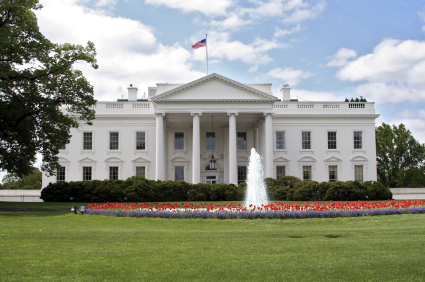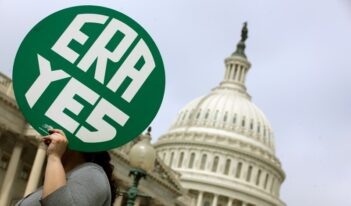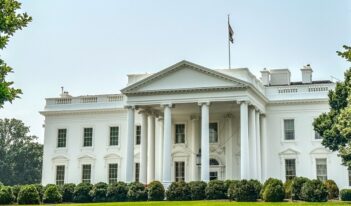
This closely watched case highlights larger lessons about the limits on executive power.
In the final days of its term, the Supreme Court resolved one of the most closely watched cases of the year—but did so with near silence. In United States v. Texas, the Court delivered a one-sentence opinion affirming, by a four-four vote, the U.S. Court of Appeals for the Fifth Circuit’s decision to enjoin the executive branch’s implementation of President Barack Obama’s controversial immigration program, known formally as Deferred Action for the Parents of Americans and Lawful Permanent Residents (DAPA). Although the Court’s opinion itself did not address the profound questions about executive power raised by the case, its near silence does highlight a larger lesson about the constitutional limits on executive power: these limits ultimately depend on the actions of the executive and legislative branches much more than on decisions of the courts.
The Texas litigation originated as a challenge to a decision by the Obama Administration to address on its own the compelling humanitarian interests raised by Congress’s failure to adopt comprehensive immigration reform. DAPA would have provided a path “out of the shadows,” to use President Obama’s words, for some four million illegal immigrants whose children are citizens or lawful permanent residents of the United States. DAPA would have permitted those parents to seek, and Department of Homeland Security (DHS) officials to grant, “deferred action”—a temporary but renewable reprieve from removal from the United States. Deferred action, in turn, would have entailed eligibility for work authorization and for certain federal and state benefits available to those whom immigration officials deem lawfully present in the United States.
United States v. Texas, of course, was not about the humanitarian merits of granting relief from removal to the class of eligible DAPA beneficiaries. Rather, the case raised important questions of federal jurisdiction and executive power that transcend the immigration context. Do states have standing to challenge executive action based on the harmful fiscal impact of that action on the states, including the impact that flows from state policy choices? How broad is the executive branch’s power to shape policy through decisions not to enforce the law against a class of individuals? What role should past non-enforcement decisions play in the analysis of the scope of executive power? How do congressional decisions about the allocation of resources to implement a complex statutory scheme affect the scope of executive discretion to apply that scheme? At what point, if any, do non-enforcement decisions breach the President’s obligation to “take Care that the Laws be faithfully executed?” Is that constitutional provision judicially enforceable?
All of these questions were packed into this single case. But now, absent a successful rehearing request from the government, the legal controversy over DAPA will return to the district court, which seems likely to convert its preliminary injunction into a permanent one. Even so, the uncertain path thus far to any authoritative resolution of the controversy by the Supreme Court underscores the reality that the political branches, more than the courts, will continue to determine the limits of executive power. The Court’s non-resolution of the difficult questions in United States v. Texas thus provides an occasion to reflect on the substantive and institutional dimensions of executive power to reshape statutory policy through non-enforcement decisions. What limits, if any, exist on that power? And who determines what those limits are?
The federal government’s brief in United States v. Texas defended the proposition that DHS has broad authority to reshape immigration policy, including through announcing its intent not to enforce the removal provisions of the Immigration and Nationality Act (INA)—the statute governing immigration law—against a large class of individuals. The government also treated what it called the “general vesting power” of the INA—that is, the provision charging DHS to administer and enforce the INA “and all other laws relating to the immigration and naturalization of aliens”—as the source of discretionary practices concededly not traceable to any specific provision of the INA.
If the INA had granted DHS nothing but sweeping authority to develop immigration policy along any lines that it wished, such a (hypothetical) statute would have given rise to serious constitutional concerns under the so-called nondelegation doctrine. Yet the government’s twin claims about both broad non-enforcement power and a “sweeping” discretionary authority under the INA would effectively produce an administrative power of similar breadth as a statute that explicitly gave DHS absolute discretion to set immigration policy any way it wished.
As the lower court decisions in the Texas litigation demonstrate, administrative law offers some tools for moderating these concerns about excessive administrative power. The district court would have required DHS to promulgate DAPA as a rule through the notice-and-comment procedures of the Administrative Procedure Act. The Fifth Circuit also viewed DAPA as exceeding DHS’s authority under the INA, perceiving a direct conflict between DAPA’s recognition of lawful presence and specific provisions of the INA dictating when a child’s citizenship or lawful permanent residence can be the basis of a parent’s transition to lawful immigration status, as well as a similar conflict between DAPA’s recognition of eligibility for work authorization and provisions of the INA designed to combat the employment of illegal immigrants.
These standard administrative law tools of statutory interpretation and administrative procedure allowed the lower courts to sidestep more fundamental, but perhaps intractable, questions about an agency’s general obligations to enforce the law. The Constitution’s admonition that the President must “take Care that the Laws be faithfully executed” suggests both that the President must undertake a good-faith effort to effectuate a congressional statute, and also that the President must have the means to prevent or respond to a breach of faith on the part of his subordinates. But absent the sort of direct statutory conflict that the Fifth Circuit found, it is difficult to pinpoint what would breach the requirement of a good-faith effort to effectuate the INA. The INA is a complex statutory scheme that, depending on the level of generality at which one analyzes the statute, can support a number of different priorities.
In addition, as others have argued, there is a profound disconnect between the INA that remains on the books and the INA as it applies “on the ground.” This gap invites the sorts of claims about unqualified discretion that the federal government has pressed with respect to DAPA. This gap also invites claims, pressed throughout the litigation over DAPA, that Congress has acquiesced in or impliedly approved past exercises of administrative power that, taken together, provide the foundation for DAPA. Leaving aside the uncertain factual predicate for such claims—which rely heavily on the use of deferred action to prevent removal of those with a far more certain and immediate entitlement to lawful status than exists for potential DAPA beneficiaries—the conceptual difficulties with this approach should make courts reluctant to accept it. Even if past practice precisely mirrored current uses of deferred action, construing congressional silence as tacit approval of executive conduct means that Congress’s failure to act works a constant expansion of executive authority.
That brings us to the institutional dimensions of the questions about whether the executive branch can use its enforcement discretion to re-shape a statutory scheme. Notwithstanding Texas’s short-term success in pursuing a challenge to DAPA in the courts, standing and other questions of justiciability will in the future work to limit judicial resolution of claims that the executive branch has, through non-enforcement decisions, failed in its obligation to effectuate a statutory scheme. If so, the political restraints on the exercise of enforcement discretion will only become more important.
If the President is to “take Care that the Laws by faithfully executed,” the executive branch itself must place its own limits on its enforcement discretion. An opinion issued by the U.S. Department of Justice’s Office of Legal Counsel accompanying DAPA reflected an attempt to articulate those limits. As I argue elsewhere, however, the Office of Legal Counsel’s opinion fell short in several respects. But the importance of executive self-restraint is one lesson not only of U.S. v. Texas but also of the case in which the judiciary most famously reined in broad assertions of presidential power: Youngstown Sheet & Tube Co. v. Sawyer, colloquially known as “the steel seizure case.”
The Youngstown case, in which the Court invalidated President Harry Truman’s seizure of steel mills during the Korean War, involved assertions of independent presidential authority under Article II that are lacking in the dispute over DAPA. Nonetheless, the lessons that Justice Robert Jackson’s concurring opinion in that case offered to the political branches apply equally well in the DAPA context. Justice Jackson spoke in Youngstown as a legal-adviser-turned judge, and his opinion was a pointed critique of the work of President Truman’s legal advisors. His message was that the advice that President Truman had authority to seize the nation’s steel mills would never have been given or followed in President Franklin Delano Roosevelt’s time. Stewardship of the presidency requires attention not only to the policy goals of its current occupant, but also to the accretion of power that overly broad assertions of executive authority will generate for future administrations. A non-enforcement power is deregulatory, and broad assertions of such a power in service of one’s favored policy goals today will invite equally broad assertions that might undermine one’s favored policy goals tomorrow.
Justice Jackson’s Youngstown concurrence also offered an important message to Congress: inertia will expand presidential power and courts will be able to do little on their own to stop it. Congress needs to act if it seeks to restrain the executive. Justice Jackson observed that he had “no illusion that any decision by this Court can keep power in the hands of Congress if it is not wise and timely in meeting its problems.” Justice Jackson spoke in particular of the power to legislate for emergencies, but the lesson applies as well to the crisis that precipitated DAPA. When congressional neglect of a statutory scheme creates such a dramatic gap between the law on the books and the law as applied, it only invites broad executive initiative—not to mention claims of implied congressional acquiescence in or approval of such initiative.
Among the many lessons of Justice Jackson’s Youngstown concurrence is that although courts can provide some limits on executive power, those limits depend first and foremost on the political branches. Broad assertions of executive power met with congressional complacency will progressively erode limits on executive authority.
This essay is part of The Regulatory Review’s seven-part series, The Supreme Court’s 2015 Regulatory Term.




